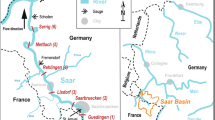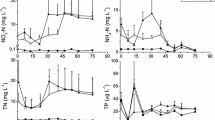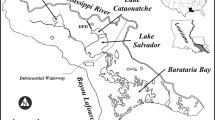Abstract
Rivers are known to be major contributors to eutrophication in marine coastal waters, but little is known on the short-term impact of freshwater surges on the structure and functioning of the marine plankton community. The effect of adding river water, reducing the salinity by 15 and 30%, on an autumn plankton community in a Mediterranean coastal lagoon (Thau Lagoon, France) was determined during a 6-day mesocosm experiment. Adding river water brought not only nutrients but also chlorophyceans that did not survive in the brackish mesocosm waters. The addition of water led to initial increases (days 1–2) in bacterial production as well as increases in the abundances of bacterioplankton and picoeukaryotes. After day 3, the increases were more significant for diatoms and dinoflagellates that were already present in the Thau Lagoon water (mainly Pseudo-nitzschia spp. group delicatissima and Prorocentrum triestinum) and other larger organisms (tintinnids, rotifers). At the same time, the abundances of bacterioplankton, cyanobacteria, and picoeukaryote fell, some nutrients (NH4 +, SiO4 3−) returned to pre-input levels, and the plankton structure moved from a trophic food web based on secondary production to the accumulation of primary producers in the mesocosms with added river water. Our results also show that, after freshwater inputs, there is rapid emergence of plankton species that are potentially harmful to living organisms. This suggests that flash flood events may lead to sanitary issues, other than pathogens, in exploited marine areas.






Similar content being viewed by others
References
Smith VH, Tilman GD, Nekola JC (1999) Eutrophication: impacts of excess nutrient inputs on freshwater, marine, and terrestrial ecosystems. Environ. Pollut. 100:179–196. doi:10.1016/S0269-7491(99)00091-3
Fouilland E, Trottet A, Bancon-Montigny C, et al (2012) Impact of a river flash flood on microbial carbon and nitrogen production in a Mediterranean Lagoon (Thau Lagoon, France). Estuar. Coast. Shelf Sci. 113:192–204
Pecqueur D, Vidussi F, Fouilland E, et al (2011) Dynamics of microbial planktonic food web components during a river flash flood in a Mediterranean coastal lagoon. Hydrobiologia 673:13–27. doi:10.1007/s10750-011-0745-x
Guadayol Ò, Peters F, Marrasé C, et al (2009) Episodic meteorological and nutrient-load events as drivers of coastal planktonic ecosystem dynamics: a time-series analysis. Mar. Ecol. Prog. Ser. 381:139–155. doi:10.3354/meps07939
Guizien K, Charles F, Lantoine F, Naudin J-J (2007) Nearshore dynamics of nutrients and chlorophyll during Mediterranean-type flash-floods. Aquat. Living Resour. 20:3–14. doi:10.1051/alr:2007011
Chu Y, Salles C, Tournoud M-G, et al (2011) Faecal bacterial loads during flood events in Northwestern Mediterranean coastal rivers. J. Hydrol. 405:501–511. doi:10.1016/j.jhydrol.2011.05.047
López-Flores R, Garcés E, Boix D, et al (2006) Comparative composition and dynamics of harmful dinoflagellates in Mediterranean salt marshes and nearby external marine waters. Harmful Algae 5:637–648. doi:10.1016/j.hal.2006.01.001
Brown JM, Felice NR, Scalfone NB, Hewson I (2012) Influence of habitat confluence on aquatic microbial assemblages in experimental mesocosms. Aquat. Microb. Ecol. 66:33–40
Naudin J-J, Cauwet G, Fajon C, et al (2001) Effect of mixing on microbial communities in the Rhone River plume. J. Mar. Syst. 28:203–227. doi:10.1016/S0924-7963(01)00004-5
Pujo-Pay M, Conan P, Joux F, et al (2006) Impact of phytoplankton and bacterial production on nutrient and DOM uptake in the Rhône River plume (NW Mediterranean). Mar. Ecol. Prog. Ser. 315:43–54. doi:10.3354/meps315043
Remane A (1934) Die Brackwasserfauna. Zool. Anz. 7:34–74
Attrill M, Rundle S (2002) Ecotone or ecocline: ecological boundaries in estuaries. Estuar. Coast. Shelf Sci. 55:929–936. doi:10.1006/ecss.2002.1036
Cushing DH (1990) Plankton production and year-class strength in fish populations: an update of the match/mismatch hypothesis. Adv. Mar. Biol. 26:249–293. doi:10.1016/S0065-2881(08)60202-3
Koroleff F (1983) Determination of ammonia. In: Grasshoff K, Ehrhardt M, Kremling K (eds) Methods of seawater analysis, 2nd ef. Verlag Chemie, Weinheim, p 150–157
Tréguer P, Le Corre P (1975) Handbook of seawater nutrient analyses. Autoanalyser II Technicon user guide, 2nd edn. Univ. Bretagne Occidentale, Laboratoire de Chimie Marine, Brest, France
Raimbault P, Pouvesle W, Diaz F, et al (1999) Wet-oxidation and automated colorimetry for simultaneous determination of organic carbon, nitrogen and phosphorus dissolved in seawater. Mar. Chem. 66:161–169. doi:10.1016/S0304-4203(99)00038-9
Zapata M, Rodriguez F, Garrido JL (2000) Separation of chlorophylls and carotenoids from marine phytoplankton: a new HPLC method using a reversed phase C8 column and pyridine-containing mobile phases. Mar Ecol Progr Ser 195:29–45
Vidussi F, Marty JC, Chiaverini J (2000) Phytoplankton pigments during the transition from spring bloom to oligotrophy in the northwestern Mediterranean Sea. Deep Sea Res 47:423–445
DuRand MD, Olson RJ (1996) Contributions of phytoplankton light scattering and cell concentration change diel variation in beam attenuation in equatorial Pacific from flow cytometry measurements of pico-, ultra and nanoplankton. Deep Sea Res 43:891–906
Lee S, Fuhrman JA (1987) Relationships between biovolume and biomass of naturally derived marine bacterioplankton. Appl Environ Microb 53:1298–1303
Utermöhl H (1958) Zur Vervollkommung der quantitativen Phytoplankton-Methodik. Mitt Int Ver Theor Angew Limnol 9:1–38
Lund JWG, Kipling C, Lecren ED (1958) The inverted microscope method of estimating algal number and the statistical basis of estimating by counting. Hydrobiologia 11:143–170
Hillebrand H, Dürselen CD, Kirschtel D, Pollingher D, Zohary T (1999) Biovolume calculation for pelagic and benthic microalgae. J. Phycol. 35:403–424
Sun J, Liu D (2003) Geometric models for calculating cell biovolume and surface area for phytoplankton. J. Plankton Res. 25:1331–1346
Mullin MM, Sloan PR, Eppley RW (1966) Relationship between carbon content, cell volume and area in phytoplankton. Limnol. Oceanogr. 11:307–311
Booth CB (1993) Estimating cell concentration and biomass of autotrophic plankton using microscopy. In: Kemp PF, Sherr BF, Sherr EB, Cole JJ (eds). Handbook of methods in aquatic microbial ecology. Lewis. pp 199–205
Putt M, Stoecker DK (1989) An experimentally determined carbon: volume ratio for marine oligotrichous’ ciliates from estuarine and coastal waters. Limnol Oceangr 34:1097–1103
Rose M (1933) Copepodes pelagiques, Faune de France 26. Paul Lechevalier, Paris
Alcaraz M, Saiz E, Calbet A, Trepat I, Broglio E (2003) Estimating zooplankton biomass through image analysis. Mar. Biol. 143:307–315
Bouvy M, Bettarel Y, Bouvier C, Domaizon I, Jacquet S, Le Floc’h E, Montanié H, Mostajir B, Sime-Ngando T, Torréton J-P, Vidussi F, Bouvier T (2011) Trophic interactions between viruses, bacteria and nanoflagellates under various nutrient conditions and simulated climate change. Environ. Microbiol. 13:1842–1857
Bell RT (1990) An explanation for the variability in the conversion factor deriving bacterial cell production from incorporation of (3H)-thymidine. Limnol. Oceanogr. 35:910–915
Whittaker RH (1952) A study of summer foliage insect communities in the Great Smoky Mountains. Ecol. Monogr. 22:1–44
Von Ende CN (1993) Repeated-measures analysis: growth and other time-dependent measures. In: Scheiner SM, Gurevitch J (eds) Design and analysis of ecological experiments. Chapman and Hall. pp 113–137
Zar JH (1984) Biostatistical analysis, 2nd edn. Prentice-Hall Inc., Englewood Cliffs
Lionard M, Muylaert K, Van Gansbeke D, Vyverman W (2005) Influence of changes in salinity and light intensity on growth of phytoplankton communities from the Schelde river and estuary (Belgium/The Netherlands). Hydrobiologia 540:105–115
Flaming IA, Kromkamp J (1994) Responses of respiration and photosynthesis of Scenedesmus protuberans Fritsch to gradual and steep salinity increases. J. Plankton Res. 16:1781–1791
Liess A, Rowe O, Francoeur SN, Guo J, Lange K, Shröder A, Reichstein B, Lefèbure R, Deininger A, Mathisen P, Faithfull CL (2016) Terrestrial runoff boots phytoplankton in a Mediterranean coastal lagoon, but these effects do not propagate to higher trophic level. Hydrobiologia. doi:10.1007/s10750-015-2461-4
Heisler J, Glibert PM, Burkholder JM, Anderson DM, Cochlan W, Dennison WC, Dortch Q, Gobler CJ, Heil CA, Humphries E, Lewitus A, Magnien R, Marshall HG, Sellner K, Stockwell DA, Stoecker DK, Suddleson M (2008) Eutrophication and harmful algal blooms: a scientific consensus. Harmful Algae 8:3–13
Fouilland E, Tolosa T, Bonnet D, Bouvier C, Bouvier T, Bouvy M, Got P, Le Floc’h E, Mostajir B, Roques C, Sempéré R, Sime-Ngando T, Vidussi F (2014) Bacterial carbon dependence on freshly produced phytoplankton exudates under different nutrient availability and grazing pressure conditions in coastal marine waters. FEMS Microbiol. Ecol. 87:757–769
Trottet A, Leboulanger C, Vidussi F, Pete R, Bouvy M, Fouilland E (2015) Heterotrophic bacteria show weak competition for nitrogen in coastal waters (Thau Lagon) in autumn. Microb. Ecol. doi:10.1007/s00248-015-0658-8
López-Flores R, Boix D, Badosa A, Brucet S, Quintana XD (2009) Environmental factors affecting bacterioplankton and phytoplankton dynamics in confined Mediterranean salt marshes (NE Spain). J. Exp. Mar. Biol. Ecol. 369:118–126
Bonnet D, Carlotti F (2001) Development and egg production in Centropages typicus (Copepoda: Calanoida) fed different food types: a laboratory study. Mar. Ecol. Prog. Ser. 224:133–148
Hessen DO, Nilssen JP (1983) High pH and the abundances of two commonly co-occurring freshwater copepods (Copepoda, Cyclopoida). Inter J Limnol 19:195–201
Chinnery FE, Williams JA (2004) The influence of temperature and salinity on Acartia (Copepoda: Calanoida) nauplii survival. Mar. Biol. 145:733–738
Brucet S, Compte J, Boix D, et al (2008) Feeding of nauplii, copepodites and adults of Calanipeda aquaedulcis (Calanoida) in Mediterranean salt marshes. Mar. Ecol. Prog. Ser. 355:183–191
Acknowledgments
This study was part of the RESTHAU project (2007-2010) “Impact of river loadings on microbial communities from Thau Lagoon” funded by the French national EC2CO program and coordinated by E. Fouilland. A. Trottet received a postdoctoral fellowship from University of Montpellier 2. D. Pecqueur received a national PhD fellowship provided by the French Ministry of Education and Research. We should like to thank Louise Oriol (UMR 7621 LOMIC, Banyuls/Mer) and Thibault Dinet for the nutrient analyses and P. Raimbault (UMR Institut Méditerranéen d’Océanologie, Marseille) for the stable isotope analyses. This project used the facilities of the Mediterranean Center of Marine Ecosystem Experimental Research MEDIMEER funded by UMR 5119 ECOSYM “Ecologie des Systèmes Marins Côtiers,” CNRS Institute of Ecology and Environment (InEE), University of Montpellier 2, IFR 129 Armand Sabatier, CNRS-GDR2476 Réseaux Trophiques Aquatiques, and Région Languedoc-Roussillon. The authors thank the two anonymous reviewers for their insightful comments and suggestions.
Author information
Authors and Affiliations
Corresponding author
Rights and permissions
About this article
Cite this article
Fouilland, E., Trottet, A., Alves-de-Souza, C. et al. Significant Change in Marine Plankton Structure and Carbon Production After the Addition of River Water in a Mesocosm Experiment. Microb Ecol 74, 289–301 (2017). https://doi.org/10.1007/s00248-017-0962-6
Received:
Accepted:
Published:
Issue Date:
DOI: https://doi.org/10.1007/s00248-017-0962-6




